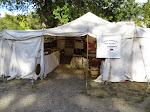I would like to continue my series on buttons this week with a discussion of china buttons. Calico buttons, which I covered in part one of this series, are a type of china but there are many, many more. This week a picture will be worth a thousand words, so here we go…
Chinas come in many sizes, colors and body shapes. Most of them were made in France. The Bapterosses plant was one of the major plants there.
One of the body shapes is called an “inkwell”. This is because it has sloping sides and resembles its namesake. Inkwells come in many different patterns, including calicos.
These buttons are “pie crust” buttons, named because of the fluted rim.
These are ringers. I have seen pictures on the Internet of clothing dating to the early 1860s that have ringer buttons on them. They have also been found on salesman’s sample cards alongside calicos, dating them to the same time period. They come in many different colors and may have a single band or two or three bands. I have some ringers that also fall under the pie crust category.
Hobnails are as the name suggests. (top row). Underwear buttons have big holes that are reminiscent of alien eyes (bottom row),
Another button that was common during the mid 19th century is the gaiter. Gaiters are rounded or conical in shape, and most have metal shanks on the bottom. Some gaiters have circular patterns and are known as “bulls-eyes”. The button on the bottom is called a “bird cage” because of the type of shank.
One of the most fun buttons is the “whistle”. Whistle buttons have one hole at the top and two holes in the bottom (the second button from the left on the bottom row shows the back side). This hides the thread inside the button and protects it from wear. These whistles are fairly plain. I have seen some that are works of art.
The last type of china that I will illustrate is the stencil. It is very hard to find information on the inception of the stencil, although we know that they ceased being made around the World War II era. At some point in the twentieth century they were also made out of aluminum. These stencils look very different from the chinas. Stencils come in several patterns and colors, although not as many patterns as calicos.
If you are interested in china buttons and want to see more, I found a wonderful website that has many pictures on it. I would recommend it for reference and if you just want the china “wow” factor.
For more information I would also recommend the book “Guidelines For Collecting China Buttons” by Ruth Lamm. It is currently out of print, but is a good handbook if you can find one.
Next week I will conclude this series with a segment on vegetable ivory, metals and perfume buttons.


No comments:
Post a Comment
Would love to hear your comments.